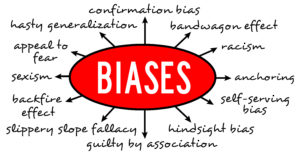Building a diverse and inclusive workforce is a priority for most organisations. Developing a robust equality, diversity, and inclusion (EDI) strategy can help a business achieve its objectives, in addition to being the right thing to do, so it makes good business sense.
Despite increasing awareness that EDI is vital to business, companies still struggle to deliver on these commitments, particularly in terms of implementation. One of the best ways an organisation can invest in their EDI strategy is to minimise unconscious biases in the workplace.
What is unconscious bias?
Unconscious biases are stereotypes and opinions which are unintentional but deeply ingrained within our beliefs and affect how we behave and respond to people. Accepting and understanding that we all have unconscious bias is the first step in minimising the impact it can have on others; another way to reduce unconscious bias is through education and training.
Type of unconscious bias
There are many types of unconscious bias. 
The below are the most common:
- Affinity bias—favouring employees who ‘fit’ with the company’s culture. This often means employing and promoting individuals with similar interests, experiences, and backgrounds to yourself.
- Confirmation bias—disproportionately rewarding an individual based on their name, places they have lived, or schools attended. This may lead to unconsciously pushing your beliefs onto others and ignoring diversity.
- Name bias—hiring or rewarding employees simply based on a person’s name. A simple way to mitigate against this is by removing names and addresses from potential candidates’ applications.
A few other common ones in the workplace are the halo or horns effect, gender bias, beauty bias, colour/culture bias, and attribution bias. All of these can negatively impact on individual and company performance, motivation, progression, and employee attrition.
Tips on mitigating/reducing unconscious bias
Admitting and understanding that unconscious bias exists within everyone is a crucial first step for leadership teams. As Ralph Waldo Emerson said ‘people only see what the are prepared to see’. But what practical steps can be taken to reduce the negative impact of unconscious bias on your team and help attract and retain a diverse workforce?
For business owners and HR teams must ACT (Acknowledge the issue, Challenge it when witnessed or heard, and Train everything to know what it is and understand how it works to help prevent the impacts) The below actions can be taken in relation to this simple process:
- Make sure employees understand stereotyping and why we all have bias. By educating the workforce about stereotyping, and recognising when they may fall into using them, you can raise awareness and keep individuals mindful of their personal stereotyping perceptions, making them more accountable for them.
- Set company-wide expectations.Let your teams know that you are prioritising bias mitigation in the business. Ensure that employees understand and know the company values on diversity, inclusion, and equity. Include a diversity statement in your organisational values, pledging the business’ commitment to diversity and inclusivity.
- Be transparent about the hiring and promotion process. By creating and implementing a fully transparent hiring and promotion process, a workforce will be assured that there is no bias towards anyone based on gender, age, race, sexual orientation, or any other factors. If you are transparent and proactive in recruiting professionals from diverse backgrounds and experiences, it will build your employees’ trust in this process. Also check your wording of job descriptions or adverts to check they don’t contain any hidden bias.
- Make leaders responsible. Ensuring business decision-makers are accountable for the organisation’s values will demonstrate the importance of an unbiased workplace.
- Have clear criteria for evaluating qualifications and performance. Having robust criteria for analysis of performance virtually eliminates the possibilities of bias impacting the appraisal process. Some businesses implement the use of blind evaluations so that the employee is represented solely by their work and not any external factors.
- Promote a culture of open dialogue and conversations. By creating a culture that promotes open expression and discussion about bias not only educates and builds trust among employees but also reinforces the businesses commitment to it.
- Regularly deliver bias training. Delivering regular bias and EDI training can benefit the entire workforce by educating employees and reassuring those who may feel excluded that the issue of bias is being discussed and is a key focus of the business.
- Offer the means of a safe space to raise anonymous complaints or issues. This provides an opportunity for employees to report an issue without fear of retaliation or victimisation from colleagues
- Don’t be afraid to ask for feedback. Include questions about bias on employee surveys, especially if the surveys are anonymous. It is also good to survey former employees or ones leaving the business about bias to understand what issues they may have faced and what steps might have helped keep them. This can help mitigate any future issues.
Reducing the negative impact of unconscious bias takes a lot of commitment, effort, and effective training for a business, but it is increasingly becoming more important to workers. By taking concrete and transparent steps to lessen the impact of unconscious bias at your company, you will certainly achieve positive results, such as reduced employee turnover, increased productivity and an overarching positive culture
For additional support and information on how to mitigate unconscious bias in the workplace, seek an independent HR advisor for guidance.


